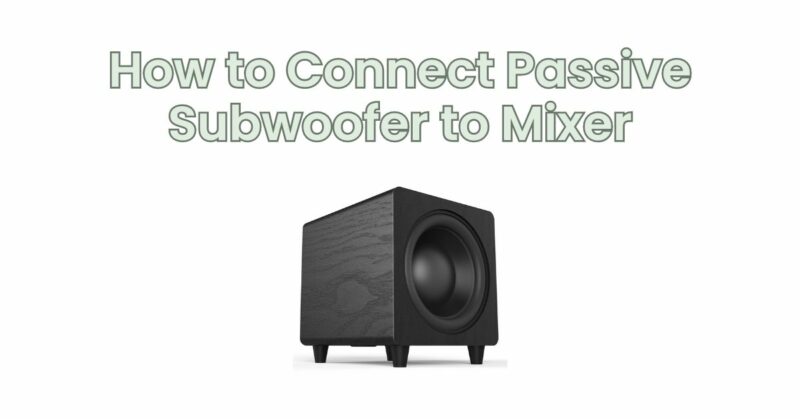Passive subwoofers are a popular choice for adding deep and impactful bass to audio systems. If you have a passive subwoofer and a mixer, you may be wondering how to connect them to create a dynamic and well-rounded sound. While the process may require additional equipment, connecting a passive subwoofer to a mixer is straightforward and rewarding. In this article, we will guide you through the steps of connecting a passive subwoofer to a mixer, enabling you to achieve a robust low-frequency response in your audio setup.
Step 1: Check Compatibility and Ports Before starting, ensure that both your passive subwoofer and mixer have compatible connection options. Passive subwoofers require external amplification, so your mixer should have dedicated subwoofer output or crossover functionality. Verify that your mixer has outputs that match the input options available on your passive subwoofer, such as speakON, 1/4-inch TS, or binding posts.
Step 2: Determine the Subwoofer Output on the Mixer Identify the subwoofer output or crossover functionality on your mixer. This output is usually labeled as “sub out,” “low-frequency out,” or “dedicated crossover.” Consult your mixer’s user manual or product specifications to locate the appropriate ports.
Step 3: Select the Correct Amplifier Since passive subwoofers require external amplification, you will need a separate amplifier or power amplifier to drive the subwoofer. Choose an amplifier that matches the power handling capabilities of your subwoofer. Ensure the amplifier has output options that match the input options on your subwoofer.
Step 4: Choose the Connection Cables Select the appropriate cables for connecting your mixer, amplifier, and passive subwoofer. Depending on the available ports, you may need speakON, 1/4-inch TS, or bare wire cables. Ensure the cables are of sufficient length to reach between the devices.
Step 5: Connect the Cables Connect one end of the cable from the subwoofer output on your mixer to the corresponding input on your amplifier. If using speakON connectors, align the tabs and twist to lock them in place. For other connectors, insert the plugs firmly into the jacks.
Next, connect the output terminals of the amplifier to the input terminals on your passive subwoofer. Ensure a secure connection by tightening any binding posts or screw terminals.
Step 6: Adjust Subwoofer Settings On the amplifier, adjust the volume level and any other settings according to the subwoofer’s requirements and your listening environment. Refer to the amplifier’s user manual for specific guidance on optimal settings.
Step 7: Set Mixer Levels On your mixer, adjust the output levels for the subwoofer. This may involve setting the level control for the designated subwoofer output or adjusting the overall mix to accommodate the added low-frequency response.
Step 8: Test and Fine-Tune Play audio through your mixer and monitor the performance of the passive subwoofer. Listen for a balanced sound, ensuring that the subwoofer adds depth without overpowering the other frequencies. Fine-tune the subwoofer volume and crossover settings on the amplifier as needed to achieve the desired blend with your main speakers.
Conclusion: Connecting a passive subwoofer to a mixer requires additional equipment but opens up opportunities for deep and powerful bass reproduction. By following the steps outlined in this article and ensuring compatibility between your passive subwoofer, amplifier, and mixer, you can integrate the subwoofer seamlessly into your audio system. Enjoy the enhanced low-frequency response and immersive audio experience that a passive subwoofer brings to your sound setup. Experiment with settings, monitor the sound balance,and fine-tune the subwoofer to achieve optimal performance. With the right connections and adjustments, your passive subwoofer will add a new dimension to your audio, providing a rich and impactful bass that complements the rest of the sound spectrum. Embrace the power of low frequencies and immerse yourself in a dynamic audio experience that will elevate your enjoyment of music, movies, or any other content that comes to life with the addition of a passive subwoofer.


